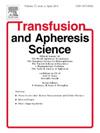红细胞摘除术在治疗红细胞增多症中的临床应用
IF 1.2
4区 医学
Q4 HEMATOLOGY
引用次数: 0
摘要
背景本研究旨在阐明红细胞摘取术治疗真性红细胞增多症和继发性红细胞增多症的临床应用价值。材料与方法回顾性分析了83例患者(84.34 %男性,平均年龄49.66岁(16.23岁)),这些患者在2021年9月至2025年4月期间共接受了104次红细胞穿刺。测量的关键参数包括红细胞(RBC)减少、血红蛋白(HB)和红细胞压积(Hct)减少和不良反应。结果红细胞分离术显著降低治疗后红细胞计数(25.22 %)、HB(25.19 %)、Hct(23.62 %)、白细胞计数(23.37 %)和血小板计数(8.38 %)(p均为 <; 0.05)。中位失血量为1405.5 mL(范围1011.75-1677.5 mL)。治疗后目标Hct中位数为40 %(范围40 - 45 %)。治疗后平均Hct为47.57 %(6.54 %),高于目标,平均Hct错误率为14.23 %(12.95 %)。当替代溶液为生理盐水时,不良反应(低血压)发生率为4.81 %(104例),但仅发生在红细胞体积/重量(D/W)≥ 25 mL/kg的患者中。在光谱Optia和COM之间没有观察到显著差异。TEC血细胞分离器。讨论红细胞摘除术能有效减少红细胞增多症患者的红细胞数量。粗略计算后治疗目标Hct = 后治疗目标Hct × 0.88,我们的研究团队正式将该配方命名为“西南配方”。未来,我们将继续扩大样本量,以提高该配方的准确性,更好地指导红细胞穿刺的临床应用。本文章由计算机程序翻译,如有差异,请以英文原文为准。
Clinical application of erythrocytapheresis in the treatment of erythrocytosis
Background
This study aimed to clarify the clinical utility of erythrocytapheresis as a treatment for erythrocytosis, including polycythemia vera and secondary erythrocytosis.
Material and methods
A retrospective analysis was conducted on 83 patients (84.34 % male, mean age 49.66 years (16.23 years)) who underwent a total of 104 erythrocytapheresis sessions between September 2021 and April 2025. The key parameters measured included the depleted red blood cell (RBC) volume, the hemoglobin (HB) and hematocrit (Hct) reductions, and adverse reactions.
Results
Erythrocytapheresis significantly reduced the post-treatment RBC counts (25.22 %), the HB (25.19 %) level and the Hct (23.62 %), the white blood cell counts, (23.37 %) and the platelet counts (8.38 %) (all p < 0.05). The median depleted RBC volume was 1405.5 mL (range 1011.75–1677.5 mL). The median post-treatment target Hct was 40 % (range 40–45 %). The mean post-treatment Hct was in fact 47.57 % (6.54 %), which was higher than the target, and the mean Hct error ratio was 14.23 % (12.95 %). When the replacement solution was physiological saline, an adverse reaction (hypotension) occurred during 4.81 % of the 104 erythrocytapheresis sessions, but only in patients with a depleted RBC volume/weight (D/W) ≥ 25 mL/kg. No significant differences were observed between the Spectra Optia and COM.TEC blood cell separators.
Discussion
Erythrocytapheresis effectively reduces the RBC mass in patients with erythrocytosis.In rough terms, the post-treatment target Hct = the post-treatment Hct × 0.88, our research team has officially designated this formula as the 'Southwest Formula'. In the future, we will continue to expand the sample size to enhance the precision of this formula and better guide the clinical application of erythrocytapheresis.
求助全文
通过发布文献求助,成功后即可免费获取论文全文。
去求助
来源期刊
CiteScore
3.60
自引率
5.30%
发文量
181
审稿时长
42 days
期刊介绍:
Transfusion and Apheresis Science brings comprehensive and up-to-date information to physicians and health care professionals involved in the rapidly changing fields of transfusion medicine, hemostasis and apheresis. The journal presents original articles relating to scientific and clinical studies in the areas of immunohematology, transfusion practice, bleeding and thrombotic disorders and both therapeutic and donor apheresis including hematopoietic stem cells. Topics covered include the collection and processing of blood, compatibility testing and guidelines for the use of blood products, as well as screening for and transmission of blood-borne diseases. All areas of apheresis - therapeutic and collection - are also addressed. We would like to specifically encourage allied health professionals in this area to submit manuscripts that relate to improved patient and donor care, technical aspects and educational issues.
Transfusion and Apheresis Science features a "Theme" section which includes, in each issue, a group of papers designed to review a specific topic of current importance in transfusion and hemostasis for the discussion of topical issues specific to apheresis and focuses on the operators'' viewpoint. Another section is "What''s Happening" which provides informal reporting of activities in the field. In addition, brief case reports and Letters to the Editor, as well as reviews of meetings and events of general interest, and a listing of recent patents make the journal a complete source of information for practitioners of transfusion, hemostasis and apheresis science. Immediate dissemination of important information is ensured by the commitment of Transfusion and Apheresis Science to rapid publication of both symposia and submitted papers.

 求助内容:
求助内容: 应助结果提醒方式:
应助结果提醒方式:


